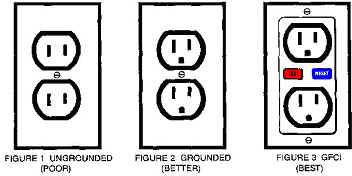| Chapter 6
Electrical Safety
U.S. Consumer Product Safety Commission
When using an electrical device like a sunless system at home or in your
business, certain basic steps should be followed to help eliminate possible
electrical shock. Electrical receptacle outlets in walls and floors may
present shock and electrical fire hazards to users. The U.S. Consumer
Product Safety Commission (CPSC) estimates that 3,900 injuries associated
with electrical receptacle outlets are treated in hospital emergency rooms
each year. CPSC estimates that electric receptacles are involved in 5,300
fires annually which claim 40 lives and injure 110 consumers.
Older homes and businesses may have receptacles that are damaged or which,
otherwise, may have deteriorated over the years. In one case of a damaged
receptacle, a woman suffered severe burns to her hand as she was plugging
in a floor lamp. Part of the plastic faceplate of the outlet had broken
away, allowing the prongs of the plug to bridge from the electrical contacts
to the grounded strap, resulting in intense electrical arcing.
Outlets also deteriorate from repeated use, from plugging-in and unplugging
appliances as is often done in kitchens and bathrooms. As a result, when
plugs fit loosely into receptacles, especially the two-prong ungrounded
type, they may slip partially or completely out of the receptacle with
only slight movement of the attached cord. Receptacles in this condition
may overheat and pose a serious fire hazard; if covered by a curtain or
drape, the fire hazard is even greater.
Only a qualified person should replace deteriorated and damaged receptacles
and, when necessary or required by law, upgrade electrical systems to
present safety standards. The simplest and most effective method to protect
against electrocution is through the installation of ground- fault circuit
interrupters (GFCIs) (as shown in FIGURE 3).
 Another
method of protection in the home or work place is to install 3-wire receptacles
that will accept either 2- or 3-prong plugs (as shown in FIGURE 2). This
method, however, requires a grounding conductor that may or may not be
available in the outlet box. The least acceptable method is installing
another 2-wire receptacle that requires the use of an adapter for accepting
3-wire plugs. Even though the tab on the adapter may be properly connected
to the cover-plate screw, the grounding path may not be adequate to protect
against ground faults. Another
method of protection in the home or work place is to install 3-wire receptacles
that will accept either 2- or 3-prong plugs (as shown in FIGURE 2). This
method, however, requires a grounding conductor that may or may not be
available in the outlet box. The least acceptable method is installing
another 2-wire receptacle that requires the use of an adapter for accepting
3-wire plugs. Even though the tab on the adapter may be properly connected
to the cover-plate screw, the grounding path may not be adequate to protect
against ground faults.
What To Look Out For
Outlets with poor internal contacts or loose wire terminals may become
overheated and emit sparks. Even a receptacle with nothing plugged into
it may run hot if it is passing current through to other outlets on the
same circuit. To prevent damage to receptacles, appliances like sunless
spray systems should be switched-off before unplugging from a receptacle.
- Have a qualified electrician replace damaged receptacles or those
which feel hot, emit smoke or sparks, those with loose fitting plugs
or those where plugged-in lamps flicker or fail to light.
- Do not unplug a sunless system by pulling on the cord at an angle.
The brittle plastic face of the wall receptacle may crack and break
away, leaving live parts of the receptacle exposed.
- To protect young children, parents should consider some precautions:
- Insert plastic safety caps into unused outlets within reach of young
children.
- Be sure that plugs are inserted completely into receptacles so that
no part of the prongs are exposed.
The U.S. Consumer Product Safety Commission protects the public from
the unreasonable risk of injury or death from 15,000 types of consumer
products under the agency's jurisdiction. To report a dangerous product
or a product-related injury, you can call CPSC's hotline at (800) 638-2772
or send the information to info@cpsc.gov.
Consumers can obtain additional information from CPSC's web site at publications@cpsc.gov.
|